I love research, scientific research, or better yet, sport scientific research, but I try to not become blindsided by it. We have to realize that research has a completely different goal from coaching. It is a different process altogether, and always targeted towards generalizable results and guidelines for the average person.
But in elite sports there is no average person, we are working with a small population of genetic freaks, outliers, from the range of average. In elite sports small differences between individuals can make a tremendous difference in performance and create the difference between an Olympic champion and not making the finals. We are looking for marginal gains, below the level of statistical significance.
So I don’t really care about the average result of a scientific research project in sport, often conducted with average athletes. The consequence is that I have to take a close look at each individual that I am coaching and try figure things out.
Profiling an athlete is an important part of my concept of training and coaching. A few weeks ago, together with a very smart young sport scientist and coach, Dr. Kornelius Kraus from Muenich, we decided to conduct a small case-study with one athlete only as a kind of possible blueprint. We looked for a few aspects here.
1. Finding out the individual muscular recruitment patterns, like left/right balance, quad activity, hamstring activity, and glute activity
2. The effect of wearable resistance on muscle recruitment
3. The effect of KAATSU on muscle recruitment
Be aware that this is not something you have to do with you with your athletes, it is a summary of some things that we did, since we thought this was important for us to know about this particular athlete. So don’t copy, just read, try to understand the underlying principles and adapt to your own and your athlete’s needs and specific environment.
We measured muscular activity by measuring EMG of L and R quads, L and R hamstrings, and L and R glutes and stored and processes these data: QL/QR, HL/HR, GL/GR.
From the EMG we derived the average as well as the peak EMG during a defined duration.
I won’t bore you with the results more than 30 exercises and drills that we tested, but chose a few examples only. The subject is a young athlete, who recently started training for sprint.
First we look at the basic muscular activity during rest, supine position (approx. 1 minute)
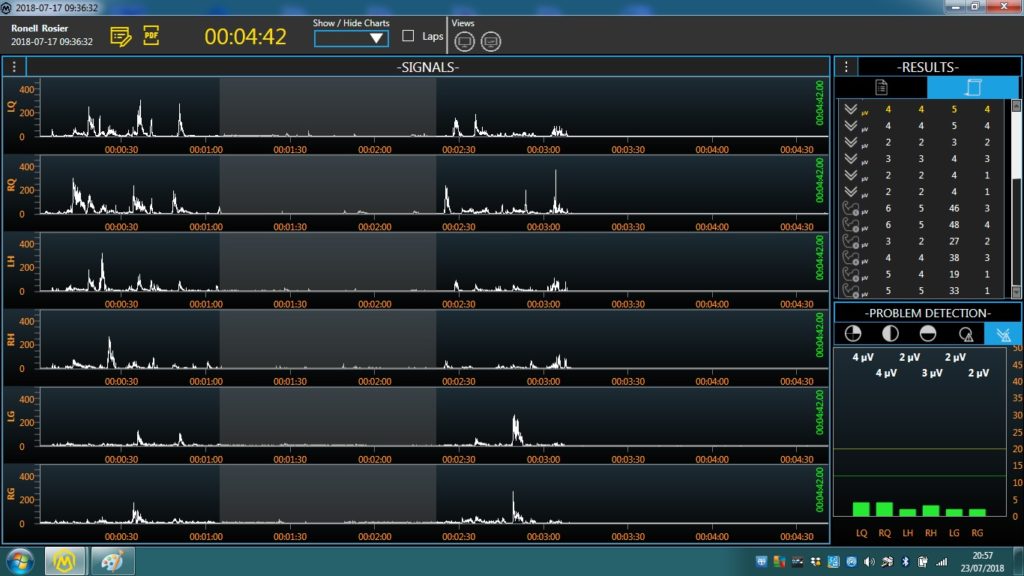 The grey zone is the processed duration of the EMG measurement. The green light down right indicate there are no L/R imbalances in rest and the EMG activity is low (< 6 microvolt).
The grey zone is the processed duration of the EMG measurement. The green light down right indicate there are no L/R imbalances in rest and the EMG activity is low (< 6 microvolt).
The next exercise is the unloaded squat (40 reps)
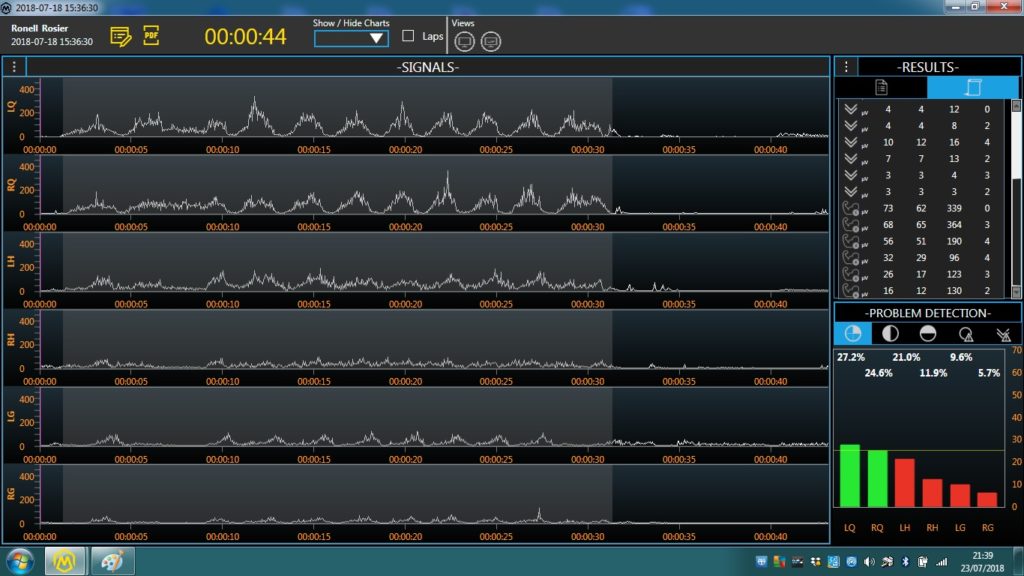 We see a nice L/R balance in the quads and hamstring, but an imbalance and low activity in the glutes.
We see a nice L/R balance in the quads and hamstring, but an imbalance and low activity in the glutes.
For the first time this athlete lifted weights and performed 10 hex squats with 30 kgs (67 lbs).
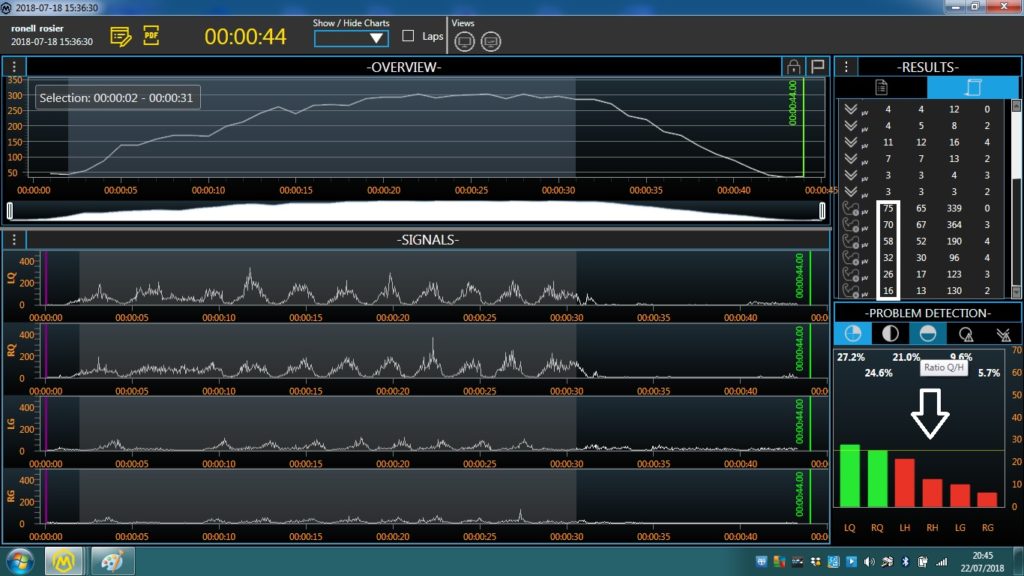 We see an increased activity of quads, hamstrings and glutes, with the L hamstring and L glute becoming dominant, a higher EMG activity than the R hamstring and R glute.
We see an increased activity of quads, hamstrings and glutes, with the L hamstring and L glute becoming dominant, a higher EMG activity than the R hamstring and R glute.
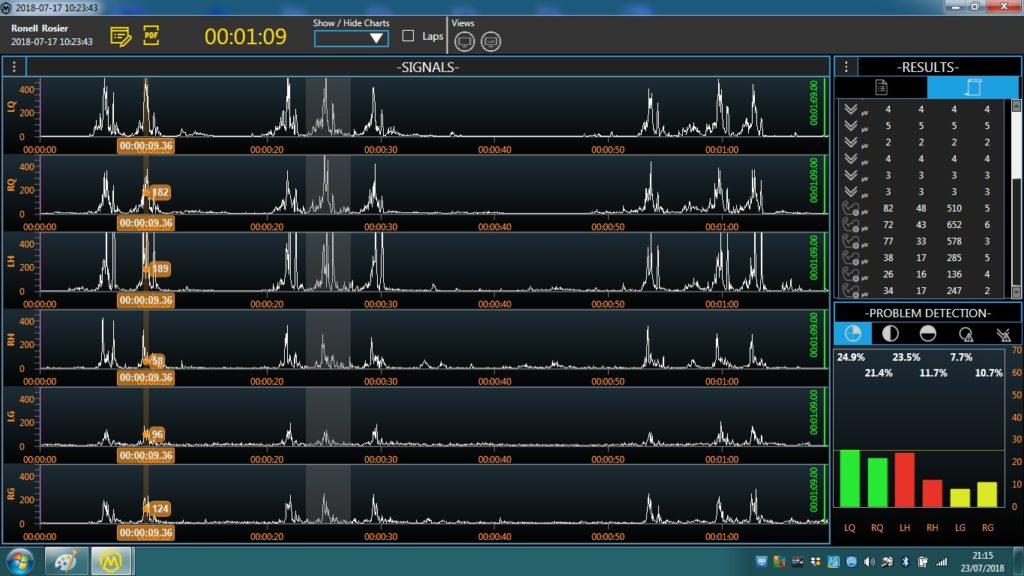 More explosive activity in the simple counter-movement jump with armswing, (or vertical jump) Again we see a higher activity in all muscle groups, and again an imbalance in the L vs. R hamstring
More explosive activity in the simple counter-movement jump with armswing, (or vertical jump) Again we see a higher activity in all muscle groups, and again an imbalance in the L vs. R hamstring
The last exercise is 50 meter sprinting from standing start (30 meter acceleration + 20 m flying).
A somewhat higher overall muscular activity, still to be expected, but a reversal of dominance: now the hamstrings activity is higher than the quadriceps activity. In the sprint of this athlete we see a higher activity of hamstrings and glutes at the expense of the quadriceps activity. A summary in numbers you find in the graph below.
Table 1.
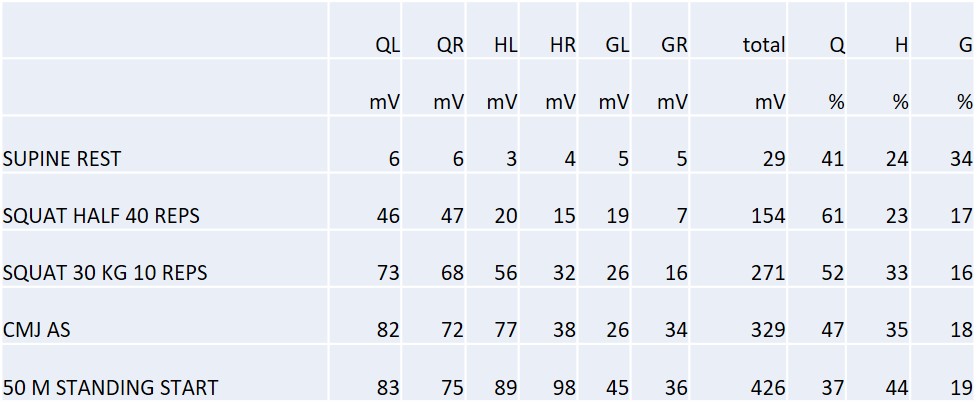 QL = quadriceps left, QR = quadriceps right, HL = hamstrings left, HR = hamstrings right, GL = gluteus left, GR = gluteus right, total = sum of all six muscle groups, % = percentage based on total (= 100%)
QL = quadriceps left, QR = quadriceps right, HL = hamstrings left, HR = hamstrings right, GL = gluteus left, GR = gluteus right, total = sum of all six muscle groups, % = percentage based on total (= 100%)
The real issue however, is not the measurement itself, but the interpretation of the numbers!
So what does it mean if e.g. in the 30 kg squat the left quad shows an activity of 82 and the right quad of 72 mV? How is this related to strength? One could state that the left quad is stronger based on the recruitment of more muscle fibers, which means the right quad is weaker and needs to be focused on.
Or is the left quad weaker, and that is why it has to recruit more muscle fibers as a compensation? Or is it just something else, a leg length difference, a pelvic imbalance or tilt, or just a matter of not having stabilized the movement pattern because this is the first time?
This is rather simple to find out, we make a force-velocity curve in leg extension (or better: knee extension) equipment, to have a better look at the cause of this imbalance and to see with quad is stronger, but that is something for a next post.
So what could we learn from these tests?
1. The balance between e.g. quadriceps and hamstrings changes as the movement velocity and the load change. This is important since many of us detect a muscular imbalance by testing one movement of exercise only. This will not tell you the whole story and often only will give you inadequate information, leading to inadequate interventions!
2. The same thing applies to L/R imbalances.
For me, testing muscle function get more reliable when one looks at:
1. functional balances, e.g. stride length and contact times in sprint,
2. testing EMG or muscular activity and recruitment patterns
3. balances in strength testing e.g. leg extension and EMG Making a force/velocity diagram over the spectrum of loads, not only 1RM
4. testing in flexibility, elasticity and stiffness

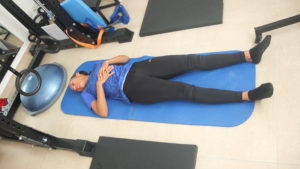


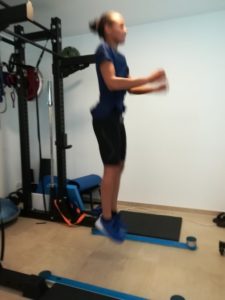
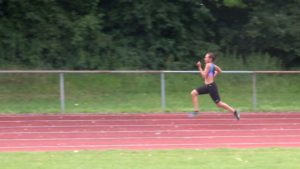

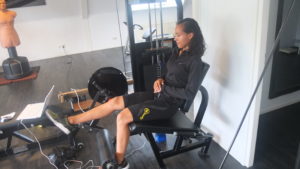
Thanks for a great writeup and sharing your knowledge.
I am an amateur runner and a competitive cross-country skier and
have been playing with EMG shorts hoping to improve technique
and skiing/running economy. There’s not much information about
how to use this technology effectively.
There are several things I am particularly interested in:
1. I keep reading how the motion should be initiated with glutes and not quads/hamstrings., but I’ve never seen a solid understandable explanation
of how to do that.
2. What is the proportion of quad/hamstrings/glutes use in runners when
speed increases? Namely, what are percentages for 100m sprinters all the
way up to marathon runners?
3. Can you recommend a good approach to using EMG for working on technique
for sports like skiing/skating where you have very fast leg push-off movement
followed by “relaxation?
Any suggestions or references are greatly appreciated.
Hello Marko, Thanks for pointing out one of the main problems here! Muscles a) work in chains and b) are recruited in a certain order. In my opinion this pattern is as individual as a running of skiing style is, and there are many styles…… This depends e.g.on limb length, strength levels, muscle fiber type and technique, to mention a few variables. Of course there is a general trend but the variation is too large to say something is wrong. I don’t only look at EMG, but also at strength levels for the same muscle groups and functional behavior as well. To put it simple: for sprinting I measure: 1. strength level and explosive strength levels(quads, hamstrings and gluteus in different angles and different velocities (isometric and F/V curve) 2. EMG activity while performing 1. and 3. measure stride length to see the effects on stride length e.g. stride length differences.
A few concepts: a therapy, intervention or workout can only be as good as the diagnosis, evaluation or test allows. A wrong diagnosis leads to a suboptimal therapy or to negative effects instead of positive.
In this complexity I see opportunity since many people shun away from complexity and prefer simple solutions for complex problems, which are always wrong.
Even if we don’t know all about the testing, the interpretation and its implementations, it still gives us more information about what we do than before. Progress comes in little steps.
To come back to your questions: 1. the main problem I found here is that the athletes often don’t recruit or use their gluteus at all in the specific movement, leave alone time its contraction properly. Also I just learned that many so called glute-exercises don’t really recruit the glutes, but its function is taken over, dependent of the exercise, by the quads (hip extension) or the hamstrings (hipflexion). It is not a matter of explaining,but just trying and learning to squeeze first the glutes at all and then do this at the right time (I am working on a set of exercises that work (EMG-tested).
The timing of the activity of these muscle groups can be judged from the measurements itself, by comparing the start of the activity of each muscle group.
2. This is a good question too, but again, my idea is that the relative proportion Q vs. H vs. G is pretty individual, but all increase with increasing velocity, as a result of the generation of horizontal and vertical forces. In the 100 meter the changes are much larger since the acceleration phase and forward lean show a different proportion than during maximal speed phase in a more upright position. In the 200 m and 400m we run 50% in the curves which again shows another pattern.
3. basically one can simply measure EMG activity in an active phase and a more passive phase of a muscle group e.g.over 10-20 strides. As a thought experiment: you want as little as EMG activity as possible, while running at the highest possible speed, showing efficiency and proper use of e.g. tendon and fascia e.g. the use of reflexive components and elastic energy. In the relaxation phase you also want little EMG activity to save energy and restore metabolic function and blood flow. So you can measure the average EMG in both phases of all three muscle groups, left and right, expressed in the sum of the six recorded EMG’s. And one of course also simultanuously record the running or skating velocity, the heart rate and or the poweroutput.
The ratio of these numbers give you the efficiency of the technical component. Simple: high totaal EMG activity and low running speed: inefficiency, while low total EMG activity and high running speed means: high efficiency, recruiting a minimal amount of muscle fibers and using a minimum amount of metabolic fuels. I hope this explanation was adequate enough, I will write another post about this soon with pictures and graphs.
I really appreciate your insights and suggestions. I guess “initiating
movement with glutes” is as dogmatic as “don’t heel-strike” while 80%+
top runners are heel strikers. I never went through a proper running
school.
I keep noticing that I am unable to do many movements using “right” muscles
as other muscles do the job.
> efficiency and proper use of e.g. tendon and fascia e.g. the use of reflexive
> components and elastic energy.
Running efficiency is related to ground contact, but in cross-country skiing and speed skating ground contact doesn’t matter (or so I think) since you want to glide (in a relaxed
state).
In your post you mention KAATSU which makes me wonder about muscle
recruitment in speed skating (maybe it applies to skiing as well). Due to
extreme crouched position and long stride times blood flow could be restricted
on the gliding leg (so, there is occlusion somehow similar to KAATSU).
So, maybe bringing in NIRS (to measure oxygenation SmO2 and blood flow ThB)
would give even more insights.
Hello Marko, thanks for keeping me sharp. First of all, measuring defies dogmatic statements. Here is an interesting article about the functioning of the gluteus: The human gluteus maximus and its role in running by Daniel Lieberman in The Journal of Experimental Biology 209, 2143-2155, 2006. The word “runners” is deceiving, from 100m runners to marathon runners, there is lot of difference in runing styles and foot contacts. Running efficiency is not only during ground contact but about all phases of the stride and the overall movement ( velocity/energy exependiture ratio) The quality of the glide also depends on the effcient storage and recoil of energy in muscle groups and muscle fibers (FT or ST) even in a non-ballistic situation like skating of skiing. I think think research with NIRS in Olympic speedskating has already been done and if not they are really late doing that. For me it would be one of the first thing to look at, especially in the curve.